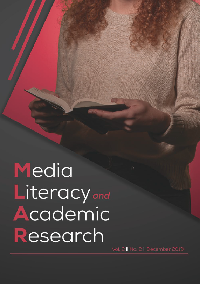Challenges And Limits Of Current Student Magazine Production - Case Study
Challenges And Limits Of Current Student Magazine Production - Case Study
Author(s): Monika Hossová, Magdaléna ŠvecováSubject(s): Social Sciences, Education, Communication studies, Sociology
Published by: Univerzita sv. Cyrila a Metoda v Trnave, Fakulta masmediálnej komunikácie
Keywords: Student media; Student magazines; Periodicals; Media education; Media literacy; Case study; Qualitative analysis;
Summary/Abstract: The subject of the study is to review the current state of contemporary student journalism.The aim of the case study is to clarify the theoretical background and then evaluation of thestate (challenges and limits) of selected student journals on the basis of defined attributes.Part of the authors' goals is also the identification of the most common errors and problems inthe analysed school magazines. At the theoretical level, the authors define the main conceptsof the issue, characterize the student media and the specifics of the creation of the media.Last but not least, the authors define the position of student media in the educational processand their contribution to education in the field of media education. Based on the theoreticaldefinition of the issue, the authors' approach is to use qualitative analysis of selected studentmagazines. The case study focuses on six student magazines from six elementary schools inSlovakia, which are involved in a research project focused on material-didactic support of mediaeducation teaching at Slovak primary and secondary schools, as well as reflexive-productivemedia learning via full-time and e-learning courses. In the research part of the case study, theauthors approach the journals via qualitative analysis in three defined categories: the contentof the journal, the graphic aspect of the journal and the organization of work in the journal /editorial office. Within these categories, journals are analysed in several specified attributes,e.g. elaborated topics, journalistic genres, journal break, colourfulness, editorial process, editingprocess and others. The conclusion of the case study is to interpret and summarize the mostimportant findings of the research and a set of recommendations that respond to the identifiedshortcomings of the analysed sample of student journals in the examined points.
Journal: Media Literacy and Academic Research
- Issue Year: 2/2019
- Issue No: 2
- Page Range: 34-51
- Page Count: 18
- Language: English

